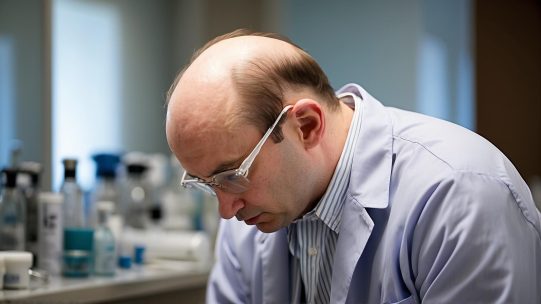Scientists have discovered skin cells underlying baldness and gray hair

Researchers at UT Southwestern Medical Center have identified the cells that directly give rise to hair and the mechanism by which hair turns gray.
This project was started to understand how certain tumors form, but we ended up finding out why hair turns gray and discovered the identity of the cells that directly give rise to hair,” UT Southwestern Cancer Center Assistant Professor Dr. Lu Le said. “With this knowledge, we may be able to create future drugs for topical application or safely deliver the necessary genes into hair follicles to address these cosmetic problems.
The researchers found that a protein called KROX20, normally associated with nerve development, is turned on in skin cells, which in this case are hair shafts. These hair progenitor cells produce a protein called stem cell factor (SCF).
When the SCF gene was removed from the hair progenitor cells of the mouse model, the animal’s hair turned white. In addition, when the KROX20-producing cells were removed, the hair did not grow and the mice became bald.
The study was published online in the journal Genes & Development.
Dr. Le, the Thomas L. Le Professor of Dermatology. Shields, says he discovered this explanation for baldness and gray hair by accident while studying a rare genetic disease that causes tumors on nerves called neurofibromatosis type 1.
Scientists already knew that stem cells in the hair follicle bulb region are involved in hair production and that SCFs are important for pigment cells, says Dr. Le, of the Hamon Center for Regenerative Sciences and Medicine.
However, they did not know what happens after the stem cells migrate to the base of the hair follicle (bulb), which cells in the follicle produce SCFs, and which cells involved in hair shaft formation produce the KROX20 protein.
If cells with functioning KROX20 and SCF are present, they migrate upward from the bulb, interact with melanocyte cells that produce pigment, and grow into pigmented hair.
However, hair in mouse models without SCF was gray and turned gray as they aged; without the KROX20-producing cells, hair did not grow.
UT Southwestern researchers will now investigate whether the KROX20 and SCF genes in the cells stop working properly with age, leading to graying and thinning hair in older adults, as well as male pattern baldness, Dr. Le said.
The study may also provide answers to why people age in general, as gray hair and hair loss are among the first signs of aging.










Comment